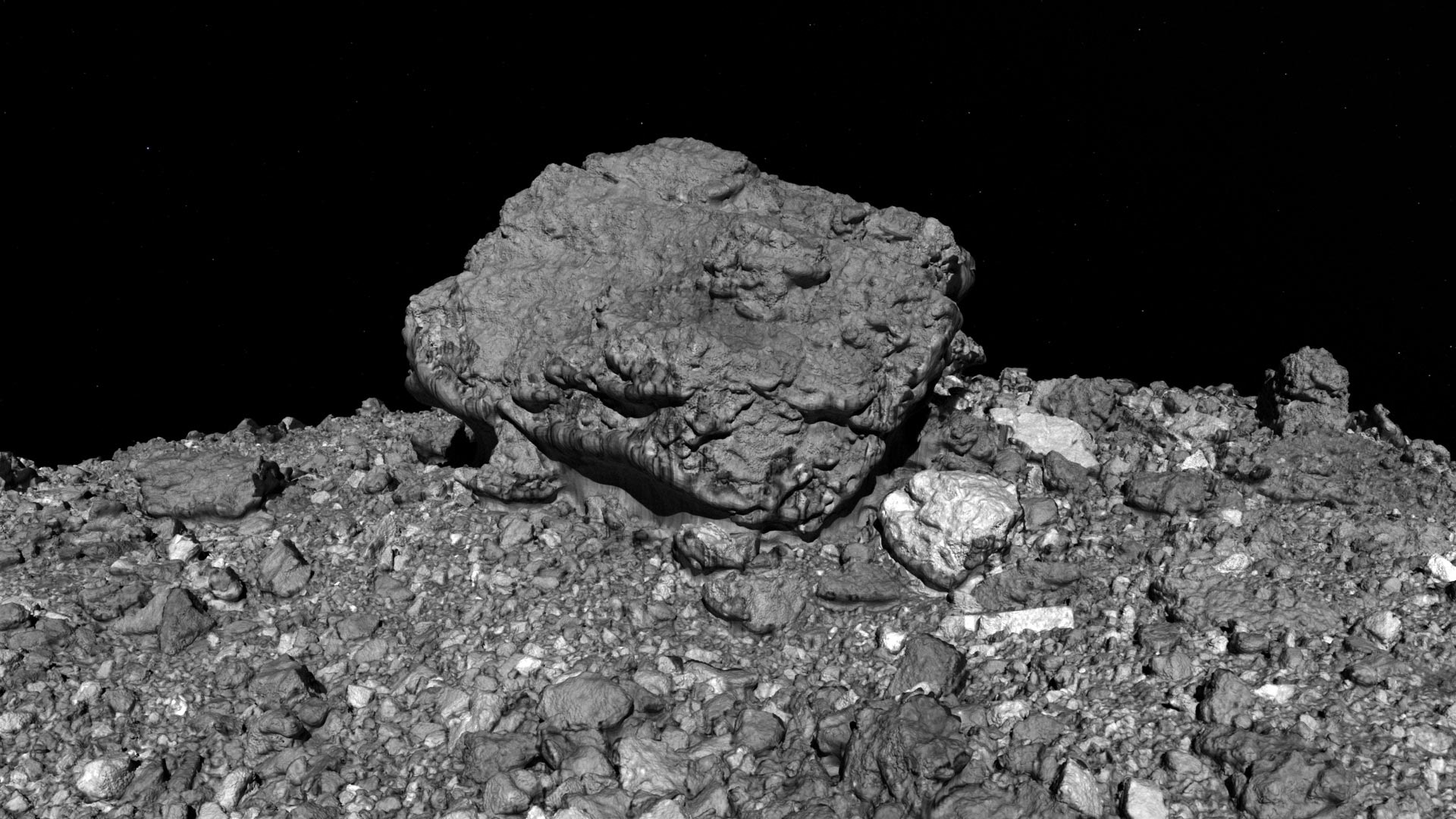وفقًا لملاحظات الحفر ، فإن السطح المغطى بصخور قلم الكويكبات يوفر الحماية ضد تأثيرات النيازك الصغيرة.[{” attribute=””>NASA’s OSIRIS-REx (Origins, Spectral Interpretation, Resource Identification, Security-Regolith Explorer) spacecraft. OSIRIS-REx traveled to near-Earth asteroid Bennu and is bringing a small sample back to Earth for study. The mission launched on September 8, 2016, from Cape Canaveral Air Force Station. The spacecraft reached Bennu in 2018 and will return a sample to Earth in 2023.
“These observations give new insight into how asteroids like Bennu respond to energetic impacts,” said Edward (Beau) Bierhaus of Lockheed Martin Space, Littleton, Colorado, lead author of a paper published in this month’s issue of Nature Geoscience.
Bennu is a “rubble-pile” asteroid, meaning that it formed from the debris of a much larger asteroid that was destroyed by an ancient impact. Fragments from the collision coalesced under their own weak gravity to form Bennu.
The team used unprecedented, high-resolution global data sets to examine craters on Bennu: images from the OSIRIS-REx Camera Suite and surface-height data (topography) derived from the OSIRIS-REx Laser Altimeter, a laser-ranging (lidar) instrument on the spacecraft.

This image shows asteroid Bennu’s boulder-covered surface. It was taken by the PolyCam camera on NASA’s OSIRIS-REx spacecraft on April 11, 2019, from a distance of 2.8 miles (4.5 km). The field of view is 211 ft (64.4 m), and the large boulder in the upper right corner of the image is 50 ft (15.4 m) tall. When the image was taken, the spacecraft was over the southern hemisphere, pointing PolyCam far north and to the west. Credit: NASA/Goddard/University of Arizona
“Measuring craters and their population on Bennu was exceptionally exciting,” said David Trang of the University of Hawaii at Mānoa, Honolulu, a co-author of the paper. “At Bennu, we discovered something unique to small and rocky bodies, which expanded our knowledge of impacts.”
Planetary scientists can estimate the age of surfaces by measuring the abundance and sizes of craters. Impact craters accumulate over time, so a surface with many craters is older than a surface with few craters. Also, the size of the crater depends on the size of the impactor, with larger impactors generally making larger craters. Because small meteoroids are far more abundant than large meteoroids, celestial objects like asteroids usually have many more small craters than large ones.
Bennu’s larger craters follow this pattern, with the number of craters decreasing as their size increases. However, for craters smaller than about 6.6 to 9.8 feet (around 2 – 3 meters) in diameter, the trend is backward, with the number of craters decreasing as their size decreases. This indicates something unusual is happening on Bennu’s surface.
The researchers think that Bennu’s profusion of boulders acts as a shield, preventing many small meteoroids from forming craters. Instead, these impacts are more likely to break apart the boulders or chip and fracture them. Also, some impactors that do make it through the boulders make smaller craters than they would if Bennu’s surface was covered in smaller, more uniform particles, like beach sand.
This activity causes the surface of Bennu to change differently than objects with fine-grained or solid surfaces. “The displacement or disruption of an individual or small group of boulders by a small impact is probably one of the most fast-acting processes on a rubble-pile asteroid’s surface. On Bennu, this contributes to making the surface appear to be many times younger than the interior,” said Bierhaus.
Reference: “Crater population on asteroid (101955) Bennu indicates impact armouring and a young surface” by E. B. Bierhaus, D. Trang, R. T. Daly, C. A. Bennett, O. S. Barnouin, K. J. Walsh, R.-L. Ballouz, W. F. Bottke, K. N. Burke, M. E. Perry, E. R. Jawin, T. J. McCoy, H. C. Connolly Jr., M. G. Daly, J. P. Dworkin, D. N. DellaGiustina, P. L. Gay, J. I. Brodbeck, J. Nolau, J. Padilla, S. Stewart, S. Schwartz, P. Michel, M. Pajola and D. S. Lauretta, 7 April 2022, Nature Geoscience.
DOI: 10.1038/s41561-022-00914-5
More about the mission and team:
The research was supported by NASA under the New Frontiers Program and the OSIRIS-REx Participating Scientist Program, the Canadian space agency, the French space agency, the Italian space agency, the European Union’s Horizon 2020 research and innovation program, and the Academies of Excellence of the Initiative D’ Excellence Joint, Excellent and Dynamic Initiative of Université Côte d’Azur.
Dante Lauretta of the University of Arizona, Tucson, is the OSIRIS-REx principal investigator. The University of Arizona also leads the OSIRIS-REx science team and the mission’s science observation planning and data processing, and built the OSIRIS-REx Camera Suite. NASA’s Goddard Space Flight Center in Greenbelt, Maryland, provides overall mission management, systems engineering, and safety and mission assurance for OSIRIS-REx. Lockheed Martin Space in Littleton, Colorado, built the spacecraft and provides flight operations. The OSIRIS-REx Laser Altimeter was provided by the Canadian Space Agency. Goddard and KinetX Aerospace are responsible for navigating the OSIRIS-REx spacecraft. OSIRIS-REx is the third mission in NASA’s New Frontiers Program, managed by NASA’s Marshall Space Flight Center in Huntsville, Alabama, for the agency’s Science Mission Directorate at NASA Headquarters in Washington, D.C.

“متعصب للموسيقى. مستكشف متواضع جدا. محلل. متعصب للسفر. مدرس تلفزيوني متطرف. لاعب.”


